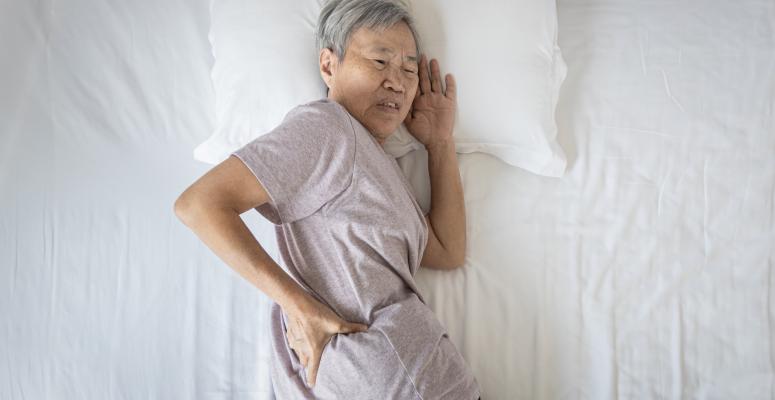
Hip pain can be a common complaint as you get older. Hip pain when lying down can make it difficult to deal with. Pain can come and go, but it’s irritating when you’re trying to rest and sleep and hip pain is plaguing you. Almost 15% of Americans aged 60 and over experienced hip pain over the course of six weeks according to one study. Several culprits could be responsible for the pain you’re experiencing.
Causes of hip pain when lying down
When your hip hurts when you’re lying down, it could be due to several different things. The most likely culprits include:
- Bursitis — The bursae are small, fluid-filled sacs that provide cushioning in the joints during movement. These bursae can become inflamed, known as bursitis. It doesn’t usually cause pain when you are standing, but is more likely to flare and cause pain when you’re lying down on the side that’s experiencing the inflammation.
- Tendinitis — Tendons in your hip connect to the pelvis and femur, allowing movement. Tendons can become irritated or injured, causing inflammation known as tendinitis. Pain from hip tendinitis can feel like a dull and deep ache.
- Arthritis — Osteoarthritis and rheumatoid arthritis can cause hip pain. Osteoarthritis can occur in up to 25% of the population in their lifetime.
- Sleep position — If your mattress is too hard or too soft, it could trigger the pressure points in your body and lead to the pain in your hip when lying down. The way you sleep also can cause pain. Sleeping on your side without a pillow between your knees can cause your hips to become unaligned and cause pain.
- Referred pain — Referred pain is when you are experiencing pain elsewhere than the actual trouble spot. Your hip pain could actually be due to lower back pain due to sciatic-piriformis syndrome.
- Pregnancy — Pregnancy puts added pressure on your spine and hips. The most pressure added is during the third trimester. This can lead to sciatica and hip pain.
Physical therapy techniques that may help hip pain when lying down
Physical therapy can help alleviate hip pain you experience when lying down. A variety of physical therapy techniques can be used to help you, such as:
- Dry needling — Dry needling can be an effective method to help alleviate hip pain. Dry needling is the process used by a certified medical professional where a thin, sterile needle is placed into the myofascial trigger point. It is intended to help stimulate muscles which can result in pain relief and improvement of your range of motion.
- Graston Technique® — The Graston Technique is an instrument assisted technique performed by a certified medical professional. With the assistance of these instruments, the practitioner can detect issues in the soft tissue and help relieve pain by breaking up scar tissue.
- Instrument-assisted soft tissue mobilization (IASTM) — IASTM is used for the treatment of soft tissue. Specially designed instruments are used by qualified practitioners to aid in pain relief of patients.
- Active Release Techniques® (ART) — ART takes several types of physical therapy and puts them into one helpful treatment choice. A physical therapist uses this hands-on approach to apply pressure to the affected area. It also involves you performing specific movements to stretch the hip area. This technique is intended to help release built-up tension in your soft tissue.
- Hydrotherapy — Hydrotherapy can be an effective physical therapy treatment for hip osteoarthritis. The reduction of gravity in the water can help patients who struggle with the ability to bear weight.
- Soft tissue mobilization — Soft tissue mobilization is a hands-on physical therapy technique that uses stretches and deep pressure to break up rigid muscle tissue, help promote muscle tension relaxation, and move trapped fluids in soft tissue causing pain and inflammation.
- Joint mobilization — Joint mobilization is a hands-on physical therapy technique where the physical therapist uses a directed application of pressure to the hip joint. The physical therapist will provide stability to one area of the hip joint while applying force to another area of the hip joint. It is intended to help alleviate pain and improve range of motion.
- Electrical stimulation — Electrical stimulation can help improve with circulation and help decrease inflammation that may be causing hip pain when lying down.
Hip pain can stop you in your tracks and keep you up at night. Physical therapy can help alleviate your hip pain when lying down.
Alliance PTP is ready to help you find top-notch PT for hip pain when lying down
At Alliance Physical Therapy Partners, we’re proudly bringing together physical therapy practices across the country to help people get the high-quality PT they need.
Want to see a physical therapist in person? We can put you in touch with an Alliance PTP partner that’s close to you and that can help you address hip pain when lying down.
Not keen on in-person PT sessions or not close to an Alliance PTP partner? No worries. We also offer effective and affordable virtual physical therapy through our Agile Virtual Physical Therapy platform.
Come find help for your injury or chronic condition today!
Get Help at a Location Near You
